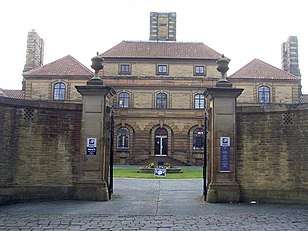Heathcote, Ilkley
Heathcote is a Neoclassical style villa in Ilkley, West Yorkshire, England. Designed by architect Edwin Lutyens, it was his first comprehensive use of that style,[1] making it the precursor of his later public buildings in Edwardian Baroque style and those of New Delhi.[2] It was completed in 1908.

In December 2014 English Heritage designated it a Grade I listed building, raising it from the Grade II* designation which it received in 1979.[3] In its new listing for Heathcote, English Heritage called it a "pivotal" building in Lutyens's career, and "an imaginative and inventive essay in Mannerism".[4] The gardens are Grade II listed in the National Register of Historic Parks and Gardens.[5]
House

In 1906,[2] Lutyens was commissioned by John Thomas Hemingway (1857–1926), a wealthy self-made Bradford wool merchant, and his wife Emma Jane, to replace their existing villa, which was at the lower, southern end of a sloping site,[6] 4 acres (1.6 ha) in extent.[7] Lutyens was given a free rein in the design. He built the new villa at the top of the site, in a size and style intended to dominate the neighbouring villas.[6] Lutyens had already mixed elements of classical architecture into his earlier, vernacular and Neo-Georgian designs, and his correspondence with Herbert Baker displayed a growing enthusiasm for classical architecture.[2] Later, he acknowledged a stylistic debt at Heathcote to the 16th-century Italian architect Michele Sanmicheli. Lutyens has been criticised for using a grand style more suited to a public building than to the Hemingways' dwelling.[6] Lutyens came to call his new style "Wrennaissance", after Christopher Wren.[8]
_(14577290668).jpg)
The house is built of local ashlar: yellow Guiseley stone decorated with grey stone from Morley,[9] with rustication on the ground floor and on the tall chimneys. The main features of the house and gardens are symmetrical around a north-south axis.[2] English Heritage have identified a compositional influence from the 17th-century French architect François Mansart.[4] The house has a three-storey central block, set back between two flanking two-storey pavilions to east and west, each with an additional one-storey outer wing. Each of these five components has a hip roof,[4] made of red pantiles.[9]
Entry is from King's Road, via a walled entrance court, to a door in the centre of the north elevation. The central hall leads out to a terrace garden giving a view southwards towards Ilkley Moor.[7] The south, garden elevation is more elaborate than the north, with wrought-iron balconies, additional setbacks in the central bay, and Doric pilasters on the flanking pavilions.[2] English Heritage have called the south elevation a "witty reinterpretation" of Michele Sanmicheli's Porta Palio in Verona.[4]
_(14577230200).jpg)
For the interior design, Lutyens continued the classical theme.[2] The vestibule floor was white marble.[10] The hall had green Siberian marble columns, a black marble staircase and a vivid green carpet. Blue was used for some other surfaces, and for the Lutyens-designed furniture.[11] He also designed star-shaped light fittings.[2] Other interior features designed by Lutyens which remain intact include the fireplaces, cabinets and cupboards.[4]
Emma Jane Hemingway died in the house in 1937.[6] The company NG Bailey used the building as offices from 1958 to 2011. After a planning application to split it into two apartments was unsuccessful, it was converted back into an eight-bedroom house in 2012.[12]
Gardens
The gardens were laid out by Lutyens,[5] with pools and parterres, and retaining walls for the terracing, including that of the central lawn.[7] The Grade I listing of 12 December 2014 combined a number of garden and courtyard features that were individually Grade II* listed, as well as some outbuildings and a pair of cottages fronting onto King's Road.[4]
The planting of the gardens was by garden designer Gertrude Jekyll.[13]
Notes
- Gradidge (1981), p. 44.
- Gradidge (1981), pp. 63–68
- "Historic home receives upgrade in grade status". Ilkley Gazette. 24 December 2014. Retrieved 6 January 2015.
- Historic England. "Heathcote (1133518)". National Heritage List for England. Retrieved 6 January 2015.
- Historic England. "Heathcote, Ilkley (park and garden) (1001219)". National Heritage List for England. Retrieved 22 February 2014.
- Brown (1996), pp. 133–136
- Brown (1982), pp. 108–109.
- Wilhide (2012), p. 32.
- Amery (1981), pp. 108–109.
- Wilhide (2012), p. 82.
- Wilhide (2012), p. 136.
- Greaves, Amanda (24 January 2013). "Call to safeguard Ilkley's Heathcote mansion after sale". Ilkley Gazette. Retrieved 21 February 2014.
- Brown (1982), p. 186.
References
- Amery, Colin (1981). "Great Houses". Lutyens: The Work of the English Architect Sir Edwin Lutyens (1869–1944). London: Arts Council of Great Britain. ISBN 0-7287-0304-1.
- Brown, Jane (1982). Gardens of a Golden Afternoon. The Story of a Partnership: Edwin Lutyens and Gertrude Jekyll. London: Allen Lane. ISBN 0-7139-1440-8.
- Brown, Jane (1996). Lutyens and the Edwardians. London: Viking. ISBN 0-670-85871-4.
- Gradidge, Roderick (1981). Edwin Lutyens: Architect Laureate. London: George Allen and Unwin. ISBN 0-04-720023-5.
- Wilhide, Elizabeth (2012). Sir Edwin Lutyens: Designing in the English Tradition. London: National Trust Books. ISBN 9781907892271.
| Wikimedia Commons has media related to Heathcote, Ilkley. |